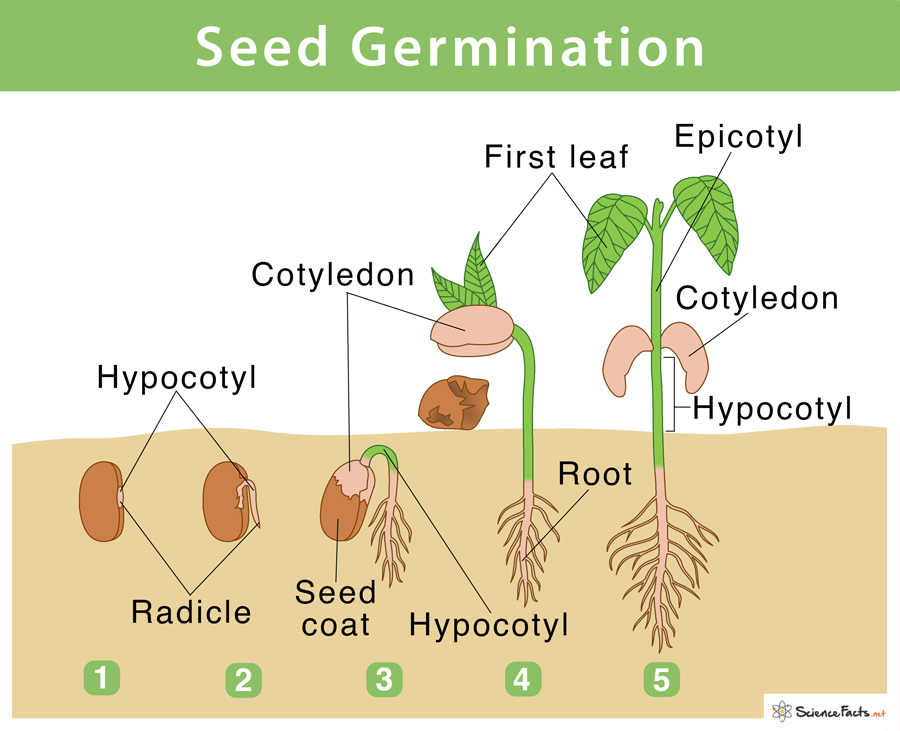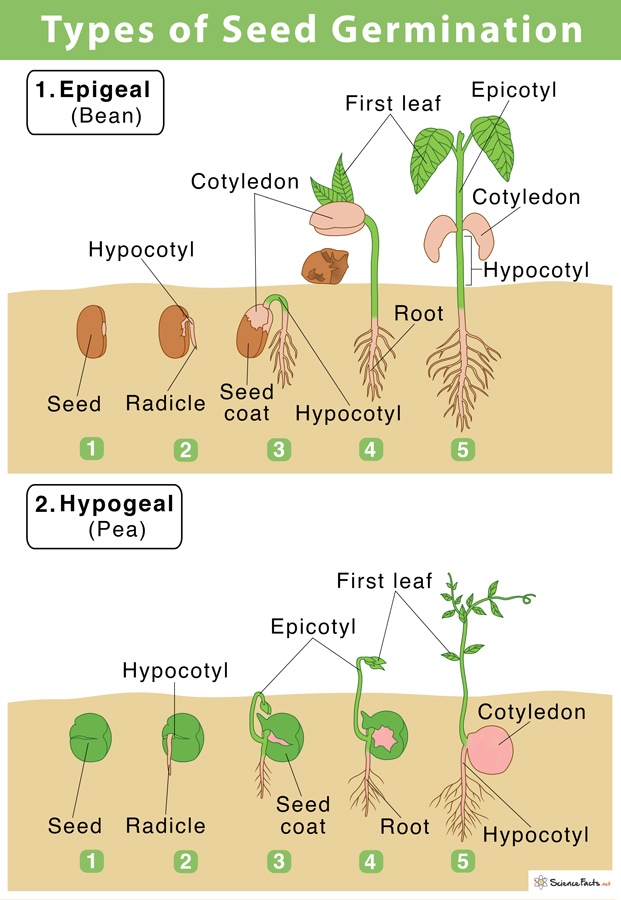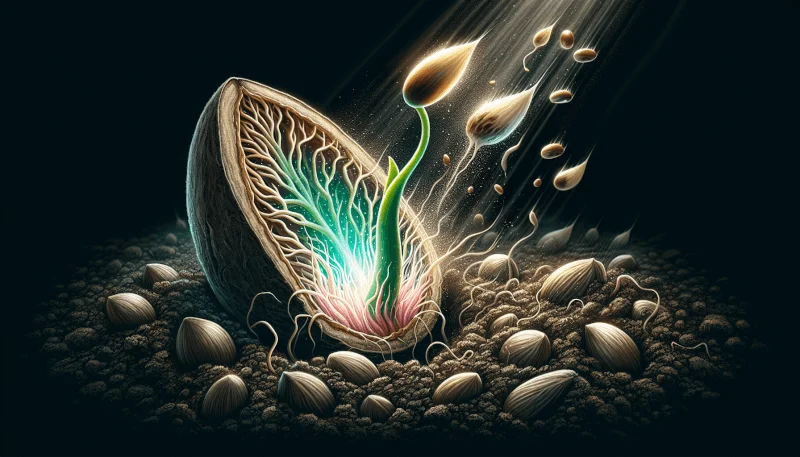
- Why Does Water Expand When It Freezes
- Gold Foil Experiment
- Faraday Cage
- Oil Drop Experiment
- Magnetic Monopole
- Why Do Fireflies Light Up
- Types of Blood Cells With Their Structure, and Functions
- The Main Parts of a Plant With Their Functions
- Parts of a Flower With Their Structure and Functions
- Parts of a Leaf With Their Structure and Functions
- Why Does Ice Float on Water
- Why Does Oil Float on Water
- How Do Clouds Form
- What Causes Lightning
- How are Diamonds Made
- Types of Meteorites
- Types of Volcanoes
- Types of Rocks

Seed Germination
What is seed germination.
Most plants that we see around us have three essential parts, roots, stems , and leaves . Once they mature, most of them bear flowers . A mango tree flowers during spring to later give rise to mango fruit . Inside the fruit, we find the seed that we discard after eating the fruit. Have you ever noticed a new plant to grow from the seed you have thrown away after eating?
The process through which a new plant develops from its seed is called seed germination.

How do Seeds Germinate: The Process with Steps
Seed germination includes a series of events happening in a sequential order, starting from an inactive seed to the formation of a baby plant:
Stage 1: Imbibition : This is the first step where the seed rapidly absorbs water from the environment causing the seed coat to swell and become soft.
Stage 2: Activation : The absorbed water activates the enzymes present inside the seed that starts the growth phase in the embryo. The seed begins respiration by absorbing oxygen and utilizing the stored food to form proteins necessary for its growth.
Stage 3: Growth (Formation of Root and Shoot) : As the rate of respiration increases, the seed coat ruptures to form a radical which later develops into a primary root, while the plumule develops into a shoot. During this period, the enzymatic activity remains at an all-time high.
Stage 4: Morphogenesis (Formation of Seedling) : This is the final step of seed germination when the first embryonic leaf or the cotyledon appears. Gradually, tiny leaves sprout from the shoot ends, these are known as foliage leaves. During this initial phase of development the baby plant continues to use the food stored within the seed. Once this phase is complete, it starts synthesizing its own food by photosynthesis .
Types of Germination in Plants

There are two main types of germination found in plants:
Epigeal Germination : Here the cotyledons are found to grow above the soil. This happens due to the rapid elongation of the region between the cotyledons and the radical in the baby plant. This region is called the hypocotyl.
Examples – Bea, Cotton, castor, papaya, onion, and gourd.
Hypogeal Germination : Here the cotyledons are found to grow below the soil. It occurs due to rapid elongation of the region between the plumule and the cotyledons in the baby plant. This region is called the epicotyl.
Examples – Pea, wheat, maize, rice, gram, and groundnut.
Apart from the above two types, a special type of germination called vivipary or viviparous germination is found in mangrove plants. The seeds of such plants cannot germinate in the soil due to high salt and low oxygen concentration in their marshy habitat. So, the embryo starts to grow within the fruit, and while still attached to the parent plant. The hypocotyl elongates, first pushing the radical out of the seed, and then out of the fruit. Gradually, the lower part of the radical becomes thick and swollen which then breaks off the parent plant, forming new roots and establishing directly as a baby plant.
Factors Affecting Seed Germination
Seeds need the right environmental conditions and a favorable internal environment to germinate. Several factors affecting the method of germination are described below:
External or Environmental Factors
1) Water : The presence of sufficient water is important to start the seed’s enzymatic activity and metabolism. As previously described, the water intake inside the seed causes the seed coat to rupture, thus allowing the seedling to emerge from the seed.
2) Temperature : This is a critical factor in germination with each seed requiring a specific temperature range. Generally, the warmer the temperature, the faster is the rate of germination. Most seeds germinate over a wide temperature range from 16°C to 24°C. Depending on the climate, some seeds germinate when the soil is cool (from -2°C to -4°C), while others require a warmer temperature (24°C to 32°C).
3) Oxygen : The respiratory rate in germinating seeds increases in the presence of oxygen. Since respiration forms the main energy source for a metabolically active seed, oxygen becomes a vital factor for germination. A seed devoid of oxygen cannot enter the metabolically active stage and remains inactive or dormant.
4) Light/Darkness : One of the most important factors for a seed to germinate is the presence/absence of light. Seeds that respond to light for germination are called photoblastic. For example, seeds of plants like lettuce and tobacco need light for germination and are called positive photoblastic seeds. In contrast, the seeds of onion and lily germinate only in darkness, being negatively photoblastic.
5) Soil Salinity : High salt concentrations in the soil inhibits water uptake by the seed, making the soil unfit for germination. This causes the seed to become dormant. Frequent watering and the use of organic fertilizers are some ways to reduce soil salinity.
Internal Factors
1) Seed Viability : The presence of growth hormone gibberellin helps the seed to germinate and become a baby plant by shedding the seed coat. An immature embryo will not germinate until it attains complete maturity. A seed can remain viable for germination for a week to many years, depending on the plant species.
2) Dormancy Period : Factors such as the presence of tough and impermeable seed coat, presence of growth inhibitors, and the absence or shortage of food supply can cause a seed to remain in an inactive or dormant state. Here, gibberellin plays an important role in breaking seed dormancy and thus making the seed return to active metabolism.
How Long Does it Take for a Seed to Germinate
As we know, the rate of germination increases by increasing the temperature. A seed usually takes 1 to 2 weeks to germinate in a warm environment. Some seeds, such as rosemary, chili pepper, and mini tomato, may even take up to 3 weeks. In contrast, some others, such as lettuce, are sensitive to high temperatures and need a cooler environment.
- Seed Germination and Dormancy – Plantcell.org
- Germination of Seeds – Bio.libretexts.org
- Seed Germination Types – Amu.ac.in
- Germination – K8schoollessons.com
- Seed Germination – Science4fun.info
Article was last reviewed on Thursday, February 2, 2023
Related articles
2 responses to “seed germination”.
You have made outstanding worksheet about Seed germinations thanks. Mrs Gilani (primary school)
Leave a Reply Cancel reply
Your email address will not be published. Required fields are marked *
Save my name, email, and website in this browser for the next time I comment.
Popular Articles

Join our Newsletter
Fill your E-mail Address
Related Worksheets
- Privacy Policy
© 2024 ( Science Facts ). All rights reserved. Reproduction in whole or in part without permission is prohibited.

The Journey of a Seed: From Germination to Sprouting
Imagine holding a tiny seed in the palm of your hand. It may seem insignificant, but within its minuscule shell lies the potential for new life. Have you ever wondered about the fascinating journey a seed undergoes, from the moment it is nestled into the soil to the magical moment when it sprouts? In this article, we will explore the remarkable process of germination and sprouting, unraveling the mysteries behind nature’s own miracle. Get ready to embark on an awe-inspiring journey as we delve into the captivating world of seeds.
Table of Contents

Introduction
Have you ever wondered how a tiny seed can transform into a beautiful plant? The journey of a seed from germination to sprouting is a fascinating process that involves multiple stages and intricate mechanisms. Understanding this journey can deepen our appreciation for the remarkable resilience and potential of nature. In this article, we will explore the stages of a seed’s journey, highlighting the key processes and transformations that occur along the way.
Stage 1: Germination
Germination marks the beginning of a seed’s transformative journey. During this stage, the once dormant seed comes to life and initiates the process of growth. Several crucial events take place during germination that enable the seed to prepare for further development.
Subheading 1: Definition of Germination
Germination is the process by which a seed transforms into a new plant. It involves the reactivation of the seed’s metabolism and the establishment of root and shoot systems. The timing and duration of germination can vary depending on plant species, environmental conditions, and other factors.
Subheading 2: Water Absorption
One of the primary triggers for germination is water absorption. As the seed absorbs water, it activates various enzymes and metabolic processes that were formerly inactive. This influx of water rehydrates the seed’s dry tissues, allowing biochemical reactions to occur.
Subheading 3: Activation of Enzymes
With the aid of water, enzymes present within the seed become active, leading to the breakdown of stored nutrients. These reserves, such as starches and lipids, provide the initial energy and nutrients necessary for the seedling’s growth. The activation of enzymes also triggers the production of important molecules, such as plant hormones, that play pivotal roles in subsequent stages.
Stage 2: Radicle Emergence
After successful germination, the radicle, which is the embryonic root, emerges from the seed. This stage sets the foundation for the development of the root system and establishes a crucial connection between the seedling and the soil.
Subheading 1: Radicle Formation
The radicle forms as a result of cell division and elongation in the embryonic root tissue. Once it emerges from the seed, it starts to grow rapidly, anchoring the seedling into the soil. The radicle’s growth is directed by various plant hormones, which provide signals for proper root positioning and orientation.

Subheading 2: Hormonal Signaling
Hormones, such as auxins, play a crucial role in radicle emergence. They stimulate cell elongation and provide directional guidance for root growth. These hormonal signals ensure that the radicle penetrates into the soil in the correct manner, facilitating the absorption of water and nutrients.
Subheading 3: Root Growth
As the radicle elongates, lateral roots begin to form, branching out from the main root. These lateral roots increase the surface area for nutrient uptake and water absorption. Additionally, the root hairs, which are tiny extensions of the root surface, further enhance the plant’s ability to extract water and minerals from the soil.
Stage 3: Cotyledon Expansion
Cotyledons are embryonic leaves that are present in the seed. In this stage, they undergo expansion and function as a temporary source of energy for the developing seedling.
Subheading 1: Cotyledon Function
The cotyledons, also known as seed leaves, provide essential nutrients and energy to the growing seedling before it can produce its own. They are usually thicker and less complex than the true leaves that will develop later. The cotyledons serve as a vital reservoir of stored nutrients, aiding the seedling’s initial development.
Subheading 2: Photosynthesis Initiation
As the cotyledons expand, they also begin to perform photosynthesis. Photosynthesis is the process by which plants convert light energy into chemical energy, allowing them to produce food and fuel their growth. The cotyledons ensure a sufficient energy supply until the seedling develops its true leaves and can sustain itself through photosynthesis independently.
Subheading 3: Nutrient Mobilization
In addition to providing energy, cotyledons also mobilize essential nutrients stored within them. These nutrients, including proteins, carbohydrates, and minerals, are transported to the growing parts of the seedling, facilitating its development. This process helps ensure a robust and healthy start for the emerging plant.
Stage 4: True Leaf Development
As the seedling continues to grow, it enters the stage of true leaf development. These leaves, unlike the cotyledons, have distinct characteristics and function as the primary organs for photosynthesis.
Subheading 1: Leaf Primordia Formation
The development of true leaves begins with the formation of leaf primordia. Leaf primordia are tiny bumps or folds that emerge from the seedling’s growing tip. They gradually elongate and differentiate into the intricate structures we recognize as leaves.
Subheading 2: Leaf Expansion
Once the leaf primordia have formed, they start expanding, unfurling into their full size and shape. This expansion is driven by cell division and enlargement, allowing the leaf to reach its maximum surface area for light absorption and gas exchange.
Subheading 3: Chlorophyll Production
During leaf expansion, chlorophyll, the pigment responsible for capturing sunlight, is synthesized. Chlorophyll gives leaves their green color and plays a crucial role in photosynthesis. With the production of chlorophyll, the true leaves become capable of converting light energy into chemical energy, further supporting the growth and development of the plant.
Stage 5: Shoot Elongation
In this stage, the focus shifts to the growth and elongation of the shoot system, which consists of stems and branches. Shoot elongation is vital for the plant’s ability to reach sunlight and maximize photosynthesis.
Subheading 1: Stem Growth
Shoot elongation begins with the growth of the stem, which is responsible for supporting the leaves and facilitating the upward movement of the plant. The stem undergoes cell division and elongation, allowing it to extend upwards towards the light source.
Subheading 2: Internode Development
As the stem grows, it develops distinct sections called internodes. Internodes refer to the spaces between leaves or branches along the stem. The length and number of internodes impact the overall height and structure of the plant, ensuring efficient light capture and optimal positioning of leaves.
Subheading 3: Apical Dominance
During shoot elongation, the plant’s growth is regulated by apical dominance. The apical bud, located at the tip of the stem, produces hormones that inhibit the growth of lateral buds. This mechanism directs the plant’s resources towards vertical growth and strengthens the main stem, ensuring the plant’s stability.

Stage 6: Sprouting
The final stage of a seed’s journey is sprouting, where the plant emerges above the ground and becomes visible to the world. Sprouting brings the seed’s transformative journey full circle, with the seedling ready to begin its life as a mature plant.
Subheading 1: Sprout Emergence
Sprout emergence marks the point at which the young plant breaks through the soil surface. It is a critical milestone that symbolizes the successful completion of germination and the beginning of independent growth. The emerging sprout reveals the plant’s stem, leaves, and various other structures that have developed through the previous stages.
Subheading 2: Protection Mechanisms
As the sprout emerges, the plant utilizes various mechanisms to protect itself against potential threats. For instance, thorns, spines, or hairs may develop to deter herbivores. The plant may also release chemical signals to attract beneficial insects or repel pests. These protective adaptations play a vital role in ensuring the plant’s survival and growth.
Subheading 3: Establishment of Growth
Once the sprout has successfully emerged, the plant undergoes further development, including the continuous elongation of stems, the production of new leaves, and the formation of flowers and fruits. These processes enable the plant to mature and reach its full potential, contributing to the biodiversity and beauty of the natural world.
The journey of a seed from germination to sprouting is a captivating tale of resilience, growth, and transformation. From the absorption of water to the emergence of the sprout, each stage is a testament to the complex mechanisms and biological processes that drive a tiny seed towards becoming a flourishing plant. By understanding and appreciating this incredible journey, we can gain a deeper insight into nature’s mastery and the remarkable potential that lies within even the smallest of seeds. So next time you see a seed germinate and sprout, take a moment to marvel at the incredible journey it has embarked upon and the beauty that awaits.

Share this:
- Click to share on Twitter (Opens in new window)
- Click to share on Facebook (Opens in new window)
Related posts:
- Sprouting Seed and Germination Guide
- Seed Sprouting Jar Kit
- 🌱 Heirloom Gardening: A Journey Through Time and Taste
- 10 Pods Plant Germination Kit Review
- The Seed Jar: A Beautiful Way to Store and Organize Your Seeds
- Seed Pods Kit Review

IMAGES
VIDEO